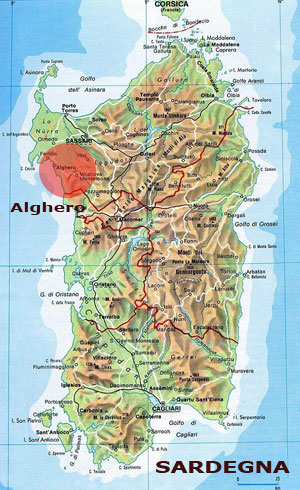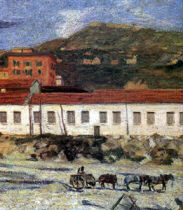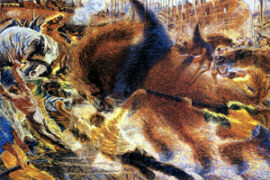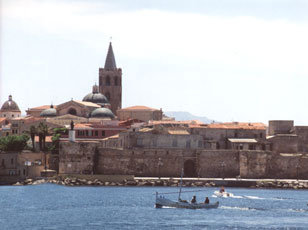Use the buttons in the audio control box to Play/Pause/Replay the audio in the dialogue. If you don't see the audio control box, check the technical requirements. Listen to the audio and repeat the sentences.
If you wish, download the audio of the lesson: ![]()
| Glossarietto |
|
| che | that |
| fare un viaggio | go on a trip, take a trip |
| per (per conoscere persone nuove) | in order to (to meet new people) |
| delle persone | some people |
| a proposito | by the way |
| dell'amicizia | about friendship |
| non lo so | I don't know it |
| non ci ho mai pensato | I have never thought about it |
| grave | serious |
| va be' (va bene) | ok |
| più | more |
| che mi è piaciuto di più | that I have liked the most |
| com'è? | how is it? What does it look like? |
| mura fortificate | fortified walls |
| cupola | dome |
| pescare | to fish |
| aragosta | lobster |
| che buone | how good |
| mi piacciono | I like (them) |
| quello che è importante | that which is important |
| magari | maybe |
| intanto | meanwhile |
| giro del mondo | world tour |
| non è vero che... | it is not true that... |
Deluso dai suoi "amici cattivi", Pinocchio decide di partire per un viaggio in Italia e di scoprire cosa è la vera amicizia. In questo dialogo saluta il suo amico Paolo.
Paolo: Allora Pinocchio, ho saputo che vai a fare un viaggio, è vero?
Pinocchio: Sì, è vero, vado a fare un viaggio per conoscere persone nuove. Ho già fatto la valigia. Vado in Italia per conoscere delle persone e per capire che cosa è l'amicizia. A proposito, tu cosa pensi dell'amicizia?
Paolo: Eh, l'amicizia... Non lo so. Non ci ho mai pensato. E' grave?
Pinocchio: No, va be'. Ti piace viaggiare?
Paolo: Sì, questa è una domanda più facile: mi piace molto viaggiare. Ho fatto molti viaggi in vita mia. E il viaggio che mi è piaciuto di più è stato in un piccolo paesino della Sardegna. Guarda, si chiama Alghero.
Pinocchio: E com'è Alghero?
Paolo: Be', è un bel paesino con mura fortificate sul mare con tanti colori, le cupole colorate e poi pescano le aragoste e mangiano tutti i giorni le aragoste*, mmm... che buone... mi piacciono molto le aragoste. Comunque, quello che è importante, che è bello, è viaggiare tanto.
Pinocchio: Hai ragione, allora magari un giorno facciamo un viaggio insieme.
Paolo: Eh, un bel viaggio nel mondo, tutto intorno, però intanto vai a vedere l'Italia, che quando torni facciamo il giro del mondo.
Pinocchio: Va bene, ciao.
Paolo: Buon viaggio allora!
*Attenzione, l'amico di Pinocchio ha detto una bugia, non è vero che ad Alghero mangiano l'aragosta tutti i giorni, è una specie protetta ed è molto costosa!

Every time you listen to an audio file, listen to it as many times as possible. While listening to the audio, read and repeat the text in Italian as a listening and pronunciation exercise. Repeat the exercise MANY times! Afterwards, RECORD YOUR VOICE as you read the text aloud in Italian. To record your voice click on "Pronuncia" on the Menu to the right. Compare your recording to the original audio.
Pinocchio: "In generale, tu perché fai un viaggio?"
Tu: " " (inserisci un'opzione)
- Per conoscere persone nuove
- Per conoscere posti nuovi
- Per divertimento
- Per lavoro
| Nel Corso Principianti abbiamo sottolineato l'importanza di "descrivere". | In the Beginner Course we have underlined the importance of "describing". |
|---|---|
| Descrivendo, (con frasi semplici e brevi), possiamo dire tante cose: presentare noi stessi e la nostra famiglia, esprimere le nostre opinioni, parlare di persone, posti o situazioni, ecc... | With descriptions (and short and simple sentences) we can say many things: we can introduce ourselves and our family, we can express our opinions, talk about people, places or situations, etc. |
| Nel Corso Principianti abbiamo paragonato la capacità di "descrivere" ad un quadro di Umberto Boccioni in cui la composizione è semplice e facile. Nel quadro "La fabbrica Foltzer" vediamo le case, la collina sullo sfondo, le carrozze, i cavalli e gli uomini: | In the Beginner Course we have compared the ability to "describe" to a painting by Umberto Boccioni, where the composition is simple and easy. In the painting "La fabbrica Foltzer" we see the houses, the hill in the background, carriages, horses and men: |

Umberto Boccioni
La fabbrica Foltzer (1908-1909)
| Nel corso Intermedio presentiamo un altro famoso quadro di Boccioni, "La città che sale", e introduciamo la "narrazione". | In the Intermediate course we present another famous painting by Boccioni, "La città che sale" (The city that is rising), and we introduce the "narration". |
|---|---|
| Nel quadro vediamo un cavallo che scappa, uomini che cercano di tenerlo, grande movimento, costruzioni, palazzi sullo sfondo e tanta animazione. | In the painting we see a horse that is escaping, men who try to hold him, a big movement, constructions, buildings in the background, and a lot of animation. |

Umberto Boccioni
La città che sale (1910)
| Nel quadro "La città che sale" Boccioni ci racconta la storia di una città animata. | In "La città che sale" Boccioni narrates the story of an animated city. |
|---|---|
| La composizione del quadro non è "semplice"; è più articolata e ci offre emozioni più forti rispetto al dipinto precedente ("La fabbrica Foltzer"). | The composition of the painting is not "simple"; it is more articulated, and it offers us stronger emotions than the previous painting ("La fabbrica Foltzer"). |
| L'artista è capace di descrivere e narrare al tempo stesso. | The artist is able to describe and to narrate at the same time. |
| Ci mostra alcuni elementi descrittivi (i palazzi sullo sfondo, il cavallo che si muove, la gente che non riesce a fermarlo) e "ci racconta" l'animazione, la velocità e la fatica di una città dinamica. Con la narrazione, l'artista può comunicarci in maniera più completa i suoi sentimenti sull'argomento che presenta. |
He shows us some descriptive elements (the buildings in the background, the moving horse, the people who cannot stop it) and he "narrates" about the animation, the speed and the fatigue of a dynamic town. With narration, the artist can communicate in a more complete way his feelings about the subject he presents. |
| Nel Corso Intermedio imparerai a "narrare" e a comunicare i tuoi sentimenti e opinioni in maniera più completa. | In the Intermediate Course, you will learn to "narrate" and to communicate your feelings and opinions in a more complete way. |
| La penna ferisce più della spada | The pen is mightier than the sword |
|---|
LDEF Lesson 1
Lesson Tools:
References:
Navigation:


